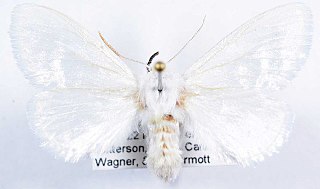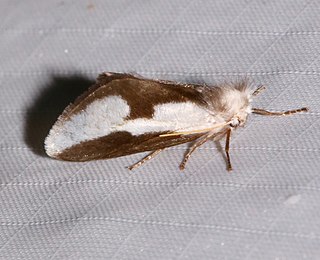
Vesta is one of the largest objects in the asteroid belt, with a mean diameter of 525 kilometres (326 mi). It was discovered by the German astronomer Heinrich Wilhelm Matthias Olbers on 29 March 1807 and is named after Vesta, the virgin goddess of home and hearth from Roman mythology.

Norape is a genus of moths in the family Megalopygidae. The genus was erected by Francis Walker in 1855.
Norape albilineata is a moth of the family Megalopygidae. It was described by Walter Hopp in 1927. It is found in Brazil.
Norape acuta is a moth of the family Megalopygidae. It was described by Walter Hopp in 1927. It is found in Costa Rica.
Norape capreolata is a moth of the family Megalopygidae. It was described by Walter Hopp in 1927. It is found in Colombia.
Norape draudti is a moth of the family Megalopygidae. It was described by Walter Hopp in 1927. It is found in Mexico.
Norape pampana is a moth of the family Megalopygidae. It was described by Walter Hopp in 1927. It is found in Argentina.
Norape truncata is a moth of the family Megalopygidae. It was described by Walter Hopp in 1927. It is found in Venezuela, Peru and Colombia.
Norape zikaniana is a moth of the family Megalopygidae. It was described by Walter Hopp in 1927. It is found in Brazil.
Norape damana is a moth of the family Megalopygidae. It was described by Walter Hopp in 1930. It is found in Brazil.
Norape dyarensis is a moth of the family Megalopygidae. It was described by Walter Hopp in 1929.
Norape plumosa is a moth of the Megalopygidae family. It was described by Arthur Gardiner Butler in 1877. It is found in Costa Rica, Panama and the Amazon region.

Norape virgo is a moth of the Megalopygidae family. It was described by Arthur Gardiner Butler in 1877. It is found from southern Texas and southern Arizona to Colombia.
Norape argyrorrhoea is a moth of the Megalopygidae family. It was described by Jacob Hübner in 1825. It is found in Argentina, Trinidad, Brazil, Guyana, Venezuela, Paraguay, Panama, Costa Rica and Mexico.
Norape cana is a moth of the Megalopygidae family. It was described by Paul Dognin in 1907. It is found in Colombia.
Norape incolorata is a moth of the family Megalopygidae. It was described by E. Dukinfield Jones in 1921.
Norape miasma is a moth of the Megalopygidae family. It was described by Harrison Gray Dyar Jr. in 1910.
Norape puella is a moth of the Megalopygidae family. It was described by Francis Walker in 1855.

Norape tener, the mesquite stinger moth, is a species of moth in the family Megalopygidae. It was described by Herbert Druce in 1897. It is found in Mexico and the south-western US.
Norape xantholopha is a moth of the Megalopygidae family. It was described by Harrison Gray Dyar Jr. in 1914. It is found in Panama, Guatemala, Colombia and Peru.



